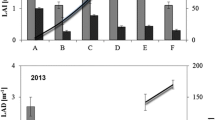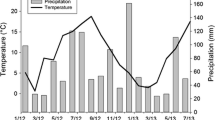Abstract
Key message
Needle age class explains most of the variability in maritime pine leaf traits. Needle size and area are related to climate and foliar nutrients. Specific leaf area is highest in stands with high site index and nutrient concentrations.
Abstract
Needle size, leaf traits and site parameters were studied in 31 Pinus pinaster plots (93 trees) located in Galicia (NW Spain). All needles were classified according to age class, and foliar nutrients were analyzed for each tree and age class. Needle age significantly affected the needle length (NLength), needle width (NWidth), needle thickness (NThickness), leaf area (projected A p and total A t), specific leaf area (SLAp and SLAt), needle tissue density (N d), N per unit leaf area (NN), average dry weight (D w) and moisture content (M u). The age class effect was the most important factor for assessing the variability in leaf dimensions. A regression model developed to predict the NLength in age class 1 indicated the importance of climate and nutritional conditions. An important proportion of the variation (25.2 %) in NLength for age classes 1 and 2 can be predicted only with spring precipitation. The SLAp was positively affected by concentrations of foliar nutrients, particularly K (FK), and showed a rather high level of plasticity considering that maritime pine is a light demanding species. The SLAp in the stands under study was higher than that of provenances from drier areas. SLAp was higher in plots located at low elevations, with good site index and nutritional status of K and Mg (FMg). Boosted regression tree analysis showed that FN contributed most to explaining needle traits. FN concentration was negatively correlated with N d, SLAp and site index.






Similar content being viewed by others
References
Álvarez-Gónzalez JG, Ruíz AD, Rodríguez R, Barrio M (2005) Ecoregional site index models for Pinus pinaster in Galicia (northwestern Spain). Ann For Sci 62(2):115–127
Assmann E (1970) The principles of forest yield study. Studies in the organic production, structure, increment and yield of forest stands. Pergarmon Press
Beets PN, Lane PM (1987) Specific leaf area of Pinus radiata as influenced by stand age, leaf age, and thinning. N.Z. J For Sci 17(2–3):283–291
Bernier PY, Raulier F, Stenberg P, Ung CH (2001) Importance of needle age and shoot structure on canopy net photosynthesis of balsam fir (Abies balsamea): a spatially inexplicit modelling analysis. Tree Physiol 21:815–830
Bond-Lamberty B, Wang C, Gower ST (2003) The use of multiple measurement techniques to refine estimates of conifer needle geometry. Can J For Res 33:101–105
Bréda NJJ (2003) Ground-based measurements of leaf area index: a review of methods, instruments and current controversies. J Exp Bot 54(392):2403–2417
Chen HYH, Klinka K, Kayahara GJ (1996) Effects of light on growth, crown architecture, and specific leaf area for naturally established Pinus contorta var. latifolia and Pseudotsuga menziesii var. glauca saplings. Can J For Res 26:1149–1157
Delzon S, Bosc A, Cantet L, Loustau D (2005) Variation of the photosynthetic capacity across a chronosequence of maritime pine correlates with needle phosphorus concentration. Ann For Sci 6:537–543
Dougherty PM, Whitehaed D, Vose JM (1994) Environmental influences on the phenology of pine. In: Gholz HL, Linder S, McMurtrie RE (eds) Environmental constraints on the structure and productivity of pine forest ecosystems: a comparative analysis. Ecol. Bull. Copenhagen. 43:64–75
Duursma RA, Marshall JD, Nippert JB, Chambers CC, Robinson AP (2005) Estimating leaf-level parameters for ecosystem process models: a study in mixed conifer canopies on complex terrain. Tree Physiol 25:1347–1359
Elith J, Leathwick JR, Hastie T (2008) A working guide to boosted regression trees. J Anim Ecol 77:802–813
Friedman JH (2001) Greedy function approximation: a gradient boosting machine. Ann Stat 29:1189–1232
Hager H, Sterba H (1985) Specific leaf area and needle weight of Norway spruce (Picea abies) in stands of different densities. Can J For Res 15:389–392
Han Q, Kawasaki T, Nakano T, Chiba Y (2008) Leaf-age effects on seasonal variability in photosynthetic parameters and its relationships with leaf mass per area and leaf nitrogen concentration within a Pinus densiflora crown. Tree Physiol 28:551–558
Hernando C, Guijarro M, De los Santos JA (1995) Determinación de la relación superficie/volumen de las acículas muertas. Investigación Agraria: Sistema de Recursos Forestales 4(1):73–85
Ishii H, Ford ED, Boscolo ME, Manriquez AC, Wilson ME, Hinckley TM (2002) Variation in specific needle area of old-growth Douglas fir in relation to needle age, within-crown position and epicormic shoot production. Tree Physiol 22:31–40
Landsberg JJ, Waring RH (1997) A generalized model of forest productivity using concepts of radiation use efficiency, carbon balance and partitioning. Forest Ecol Manage 95:209–228
Landsberg J, Mäkelä A, Sievänen R, Kukkola M (2005) Analysis of biomass accumulation and stem size distributions over long periods in managed stands of Pinus sylvestris in Finland using the 3-PG model. Tree Physiol 25:781–792
Lavorel S, Garnier E (2002) Predicting changes in communitiy composition and ecosystem functioning from plant traits: revisiting the Holy Grail. Funct Ecol 16:545–556
Loustau D, Ben Brahim M, Gaudillère JP, Dreyer E (1999) Photosynthetic responses to phosphorus nutrition in two-year-old maritime pine seedlings. Tree Physiol 19:707–715
Mediavilla S, González-Zurdo P, García-Ciudad A, Escudero A (2011) Morphological and chemical leaf composition of Mediterranean Evergreen tree species according to leaf age. Trees 25:669–677
Morgan MG, MacLean DA, Piene H (1983) Variation in balsam fir needle length due to crown position, foliage age, and intertree differences. For. Sci. 29:412–422
Niinemets Ü (1997) Role of foliar nitrogen in light harvesting and shade tolerance of four temperate deciduous woody species. Funct Ecol 11:518–531
Niinemets Ü (1999) Research review components of leaf dry mass per area—thickness and density—alter leaf photosynthetic capacity in reverse directions in woody plants. New Phytol 144:35–47
Niinemets Ü (2001) Global-scale climatic controls of leaf dry mass per area, density, and thickness in trees and shrubs. Ecology 82(2):453–469
Niinemets Ü, Kull O (1995) Effects of light availability and tree size on the architecture of assimilative surface in the canopy of Picea abies: variation in shoot structure. Tree Physiol 15:791–798
Niinemets Ü, Ellsworth DS, Lukjanova A, Tobias M (2001) Site fertility and the morphological and photosynthetic acclimation of Pinus sylvestris needles to light. Tree Physiol 21:1231–1244
Niinemets Ü, Cescatti A, Lukjanova A, Tobias M, Truus L (2002) Modification of light-acclimation of Pinus sylvestris shoot architecture by site fertility. Agric For Meteorol 111:121–140
Oleksyn J, Tjoelker MG, Lorenc-Plucinska G, Konwinska A, Zytkowiak R, Karolewski P, Reich PB (1997) Needle CO2 exchange, structure and defense traits in relation to needle age in Pinus heldreichii Christ––a relict of Tertiary flora. Trees 12:82–89
Porté A, Loustau D (1998) Variability of the photosynthetic characteristics of mature needles within the crown of a 25-year-old Pinus pinaster. Tree Physiol 18:223–232
Porté A, Bosc A, Champion I, Loustau D (2000) Estimating the foliage area of Maritime pine (Pinus pinaster Aït.) branches and crowns with application to modelling the foliage area distribution in the crown. Ann. For. Sci. 57:73–86
R Development Core Team (2009) r: a language and environment for statistical computing. R Foundation for Statistical Computing, Vienna
Ramanujan S (1914) Modular equations and approximations to π. Quart J Math 45:350–372
Richardson DM, Rundel PW (1998) Ecology and biogeography of Pinus: an introduction. In: Richardson DM (ed) Ecology and biogeography of Pinus. Cambridge University Press, Cambridge, pp 3–46
Ridgeway G (2010) gbm: generalized boosted regression models. r package version 1.6-3.1. http://CRAN.R-proyect.org/package=gbm
Roderick ML, Berry SL, Noble IR (2000) A framework for understanding the relationship between environment and vegetation based on the surface area to volume ratio of leaves. Funct Ecol 14(4):423–437
SAS Institute Inc (2004) SAS STAT® User´s guide. SAS Institute, Inc., Cary
Shelton MG, Switzer GL (1984) Variation in the surface area relationships of loblolly pine fascicles. For Sci 30(2):355–363
Stenberg P, Kuuluvainen T, Kellomäki S, Grace JC, Jokela EJ, Gholz HL (1994) Crown structure, light interception and productivity of pine trees and stands. Ecol Bull 43:20–34
Wahid N, González-Martínez SC, El Hadrami I, Boulli A (2006) Variation of morphological traits in natural populations of maritime pine (Pinus pinaster Ait.) in Morocco. Ann For Sci 63:83–92
Warren CR (2006) Why does photosynthesis decrease with needle age in Pinus pinaster? Trees 20:157–164
Warren CR, Adams MA (2001) Distribution of N, Rubisco and photosynthesis in Pinus pinaster and acclimation to light. Plant Cell Environ 24:597–609
Weiskittel AR, Temesgen H, Wilson DS, Maguire DA (2008) Sources of within- and between-stand variability in specific leaf area of three ecologically distinct conifer species. Ann For Sci 65:103
Witkowski ETF, Lamont B (1991) Leaf specific mass confounds leaf density and thickness. Oecologia 88:486–493
Xiao ChW, Ceulemans R (2004) Allometric relationships for needle area of different needle age classes in young Scots pines: needles, branches and trees. Forestry 77(5):369–382
Author contribution statement
C.E.F. participated in the acquisition of data, analysis and interpretation of results and drafting of the manuscript. F.S.R. participated in the conception of the study and its critical revision. E.A.R. provided technical assistance on nutrient analysis and interpretation of results. R.R.S. supervised the whole study.
Acknowledgments
Funding for this research was received from the Xunta de Galicia (cofunded by ERDF). We thank Christine Francis for revising the English.
Conflict of interest
The authors declare that they have no conflict of interest.
Author information
Authors and Affiliations
Corresponding author
Additional information
Communicated by L. Gratani.
Rights and permissions
About this article
Cite this article
Eimil-Fraga, C., Sánchez-Rodríguez, F., Álvarez-Rodríguez, E. et al. Relationships between needle traits, needle age and site and stand parameters in Pinus pinaster . Trees 29, 1103–1113 (2015). https://doi.org/10.1007/s00468-015-1190-7
Received:
Revised:
Accepted:
Published:
Issue Date:
DOI: https://doi.org/10.1007/s00468-015-1190-7




